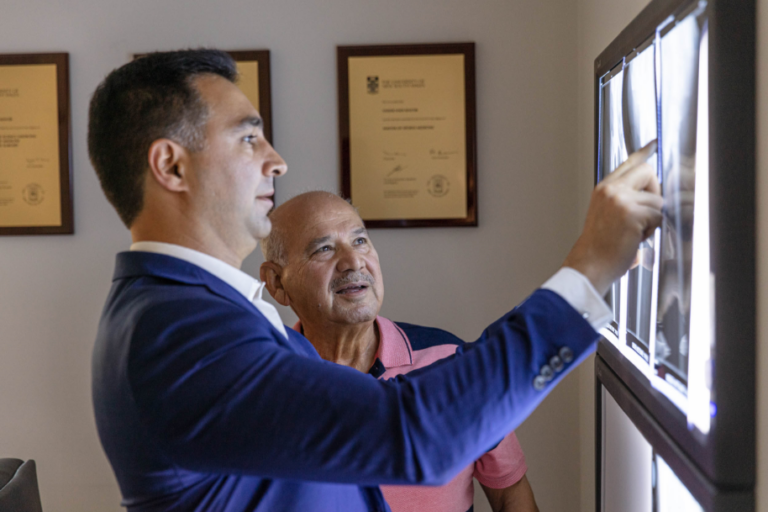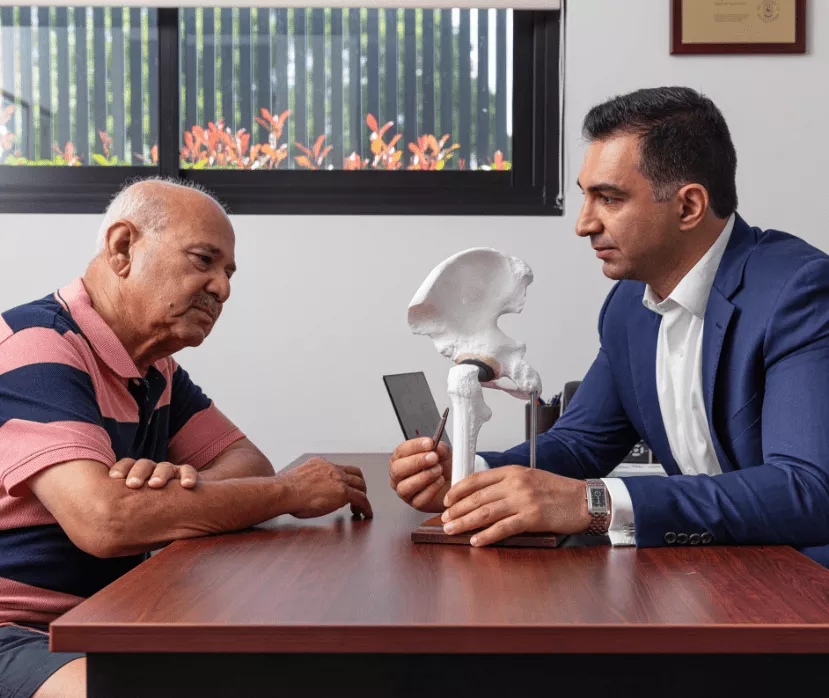Total Hip Replacement Treatments
How is Total Hip Replacement surgery performed?
The surgery is performed under general or regional (spinal or epidural) anaesthesia. The hip joint can be exposed using many different surgical approaches such as the posterior approach, direct anterior approach (DAA) or the anterolateral approach.
During the procedure a surgical cut is made over the hip, the overlying muscles are moved or split to expose the hip joint and the femur is dislocated from the acetabulum. The surface of the socket is cleaned and the damaged or arthritic bone is removed using a reamer. The acetabular component is inserted into the socket using screws or occasionally bone cement. A liner made of plastic, ceramic or metal is placed inside the acetabular component.

The femur or thigh bone is then prepared by removing the arthritic bone using special instruments, to exactly fit the new metal femoral component. The femoral component is then inserted to the femur either by press fit or using bone cement. Then the femoral head component made of metal or ceramic is placed on the femoral stem. The muscles and tendons around the new joint are repaired and the incision is closed.
What is recovery like after Total Hip Replacement surgery?
After undergoing total hip replacement, a patient usually stays in hospital between 2-5 days. The patient is given intravenous antibiotics and medication to prevent a thromboembolic event (clot in the legs or lungs). Mechanical compression pumps also help push the blood out of the leg and prevent stagnation. Patients have an x-ray while in recovery to confirm satisfactory placement of the hip components and routine blood tests are performed during the next few days to check kidney and liver function and to check for blood loss. Newer techniques in anaesthesia, surgery and the use of medication like Tranexamic acid have significantly decreased the rate of blood transfusions after surgery.
Patients usually start walking as soon as they recover from the anaesthetic. Patients may need a walking frame initially until they are stable and can use crutches or a walking stick. Most patients are discharged home if they their home environment is suitable. A small proportion may need transfer to a rehabilitation hospital.
Patients usually engage in physiotherapy after surgery and may engage in hydrotherapy 4-6 weeks after their surgery to allow appropriate wound healing and avoid the risk of contamination and infection.
Book an Appointment Today!
Precautions after Total Hip Replacement Surgery
After surgery, patients may need to take some precautions such as:
- Avoid driving a car for 6 weeks after surgery.
- The wound must be reviewed by your doctor 12-14 days after the surgery. If there is any wound disturbance or suspicion of infection then Dr Khatib’s office must be contacted.
- Take care to prevent the new joint from dislocating by:
- Avoiding combined movement of bending your hip and turning your foot inwards.
- Keep a pillow between the legs while sleeping for 6 weeks.
- Never cross your legs and bend your hips past a right angle (90 degrees).
- Avoid sitting in low chairs.
- Avoid bending down to pick up things, instead a grabber can be used to do so.
- Use an elevated toilet seat.
- Return to sedentary activities such as work in an office may be possible after 6 weeks, but more physical activities may require at least 12 weeks of recovery after surgery.

What are the risks associated with Total Hip Replacement surgery?
As with any major surgical procedure, there are certain potential risks and complications involved with total hip replacement surgery. The possible complications after total hip replacement include:
- Infection.
- Dislocation.
- Fracture of the femur or pelvis.
- Injury to nerves or blood vessels.
- Formation of blood clots in the leg veins.
- Leg length inequality.
- Hip prosthesis may wear out.
- Failure to relieve pain.
- Scar formation.
- Pressure sores.
When you come for your consultation, Dr Khatib will discuss your condition and outline all suitable treatment (surgical and non-surgical) options with you.
